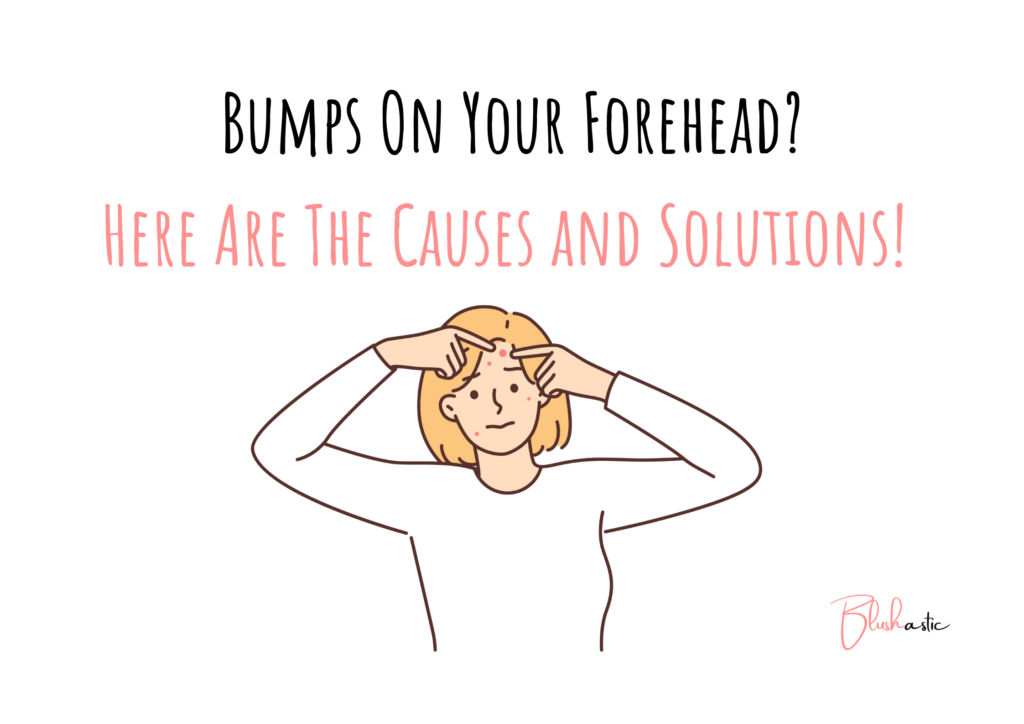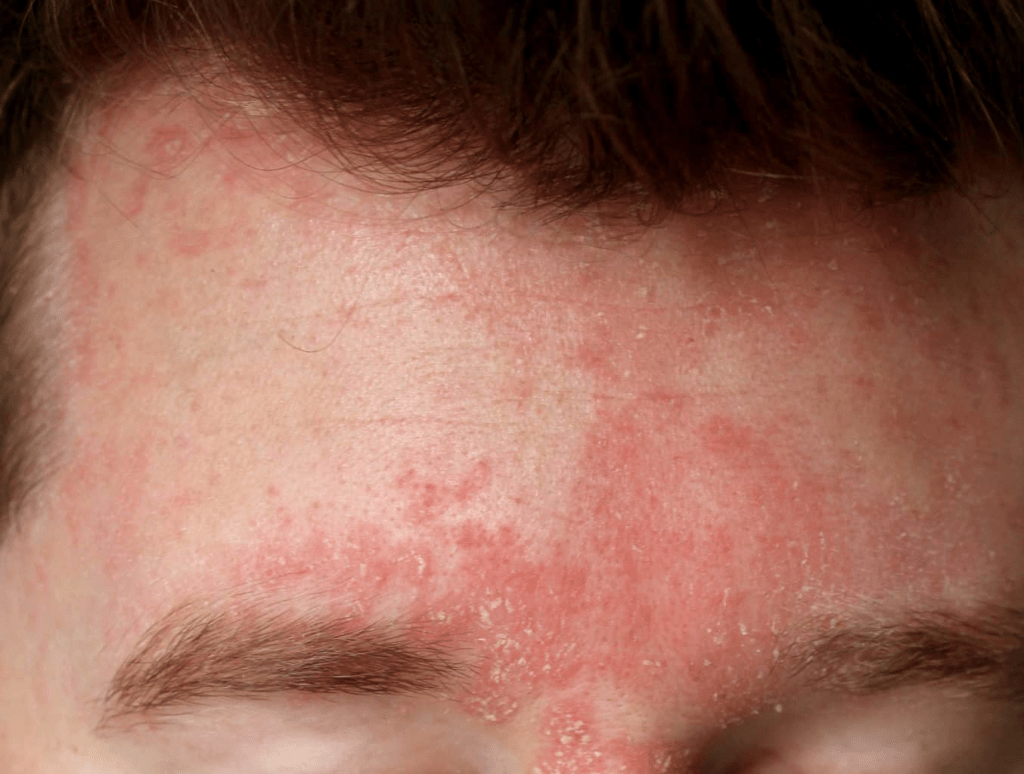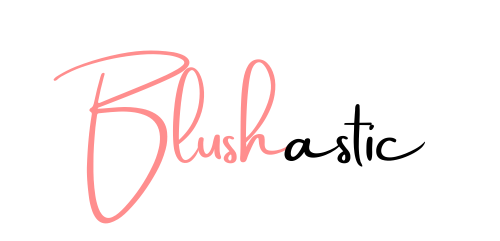Have you ever faced tiny zits suddenly appearing on your skin? While it leaves us wondering what could be the possible reason behind the bumps, it certainly takes us some time to get rid of them. But once you identify the root cause, it becomes a matter of some time before your skin texture gains its real evenness. Please do not mistake these tiny lumps to be acne or treat them likewise because the fine pimple-like bumps on forehead may indicate some other skin concerns. You will learn about its causes, solutions, treatments, and more as we delve deeper into the miniature world of pimples that wrap our skin in a rough patch.

Explore this skin condition’s possibilities and know how to deal with them correctly. Even a tiny mistake can cost us dearly when it comes to the fragility of our skin. So, without further delay, let’s begin.
Contents
Bumps On Forehead | Unmasking The Reality!
Be it newborns, teens, or adults, most of us know what tiny bumps are like. They may be painless or harmless, but if you leave them untreated for long, they may cause worry for you. Know all the possible reasons with their symptoms for the multiple little bumps on your face.
Causes and Symptoms
Keratosis Pilaris
You can get tiny bumps on any skin type at any age. When hair follicles on your skin clog due to oil, dirt, or pollution and seeps deep within your dermal layer, the protein (Keratin) plugs develop on the skin’s surface, causing stubborn bumps. It is different from sebum plugs or a type of acne that a hormonal change, stress, improper diet, and lifestyle causes. You may get acne when sebum (oil in our body to keep it moisturized) and dead skin cells clog pores on your skin.

But the main reason for Keratin plugs is the protein blockage on the skin that does not go away quickly. This skin condition is Keratosis Pilaris, mainly flesh or red-colored (during rashes). It is pain-free but can itch sometimes. Dry and flaky skin during cold winters triggers these skin conditions. Rarely one gets bumps on forehead in summer, but it’s not entirely avoidable. Due to sweat, humidity, and sun exposure, you may develop a red or pink rash that later takes the form of lumps.
Milia
Similarly, you may even develop Milia due to keratin plugs. Milia or “milky spots” usually resemble tiny dome-shaped spots having the color of your skin. It may also look like white or yellow dots. Two types of milia exist: primary and secondary, depending on the intensity of skin damage. The former clears up independently, but the latter develops afterward and may require medical intervention.
Some experts consider Milia as a part of Keratosis Pilaris. The problem arises when this skin condition becomes recurrent and headstrong. The chances of you having this skin condition are high if it may be genetic or you have asthma, obesity, eczema, dry skin, etc.
Contact Dermatitis
The red spots on the forehead, not acne, can result from the following diseases. Contact Dermatitis highlights that your skin came in contact with an allergen. It develops a rash or itch, forming tiny bumps on the forehead and other body parts. You may need to identify the surface that your skin contacts with before irritating, itching, swelling, or cracking. Most of the time, we may be unaware of the allergens surrounding us closely. For instance, jewelry metals, makeup products, skincare ingredients, perfumes, or preservatives may cause allergies. This rash may sometimes be painful when they come in touch with harsh elements like detergents, cleaners, kerosene, etc.

Rosacea
Rosacea is yet another skin condition that causes bumps on the forehead. Its symptoms occur in a cycle. It means the rosacea flare shows up again after rescinding. You may have rosacea if you are in your thirties (and above) and your face shows acne-like breakouts, bumpy skin, broken blood vessels, or swollen skin. If the itchy bumps on forehead are red, chances of you having strawberry skin may exist.
Folliculitis
Folliculitis (raised red or white bumps) results from fungal or bacterial infections. It is a skin condition that causes bumpy lumps and can be painfully itchy. It is only treatable with topical medications. When a disease infects more than one hair follicle, it causes a burning sensation.
It can stay for a while or can be long-lasting. You can get this infection from Staphylococcus bacteria or any fungi. Especially if you get in touch with shared items (razors, towels, pools, etc), you can pick up the infection. Common symptoms include rough skin texture, itching, and swelling. There are a few types of Folliculitis that your doctor may help to address.
Solutions
The standard solutions to all these problems revolve around maintaining essential skin hygiene habits. You may follow the steps that I share here.
- Cleansing your face with a gentle and mild cleanser is crucial in removing all oil, sweat, dirt, dust, and makeup pigments from the skin. Massage gently around the face in a circular motion for about a minute. Wash it off and repeat the process if you still find any debris or have super oily skin. Do it twice a day.
- Exfoliating once or twice a week helps to unclog the pores. Exfoliating acids like salicylic or glycolic acid may aid in deep cleansing and limiting oiliness. It is even helpful for acne-prone skin. Remember that exfoliants increase sun sensitivity, so avoid sun exposure after using them. But cease to use them in case of irritation.
- Toning your face is not essential, but you can still add it. Toning clears your skin and prepares you for the next step.
- Moisturizing your skin well is an uncompromising process. To keep your dry skin adversaries at bay, a good moisturizer made for your skin type is vital. Remember that all skincare products should be non-comedogenic and gentle. This step has lasting effects in hydrating your skin thoroughly and lower irritation.
- Sunscreen shields your skin from the harmful effects of UV rays. Our forehead’s high exposure to the sun always keeps it at risk. Select a broad-spectrum sunscreen covering your face and skin from UVA and UVB radiation. The latter type of sun-ray causes extreme sunburns and skin cancers.
Treatments
There are some laser therapies to treat your skin condition and to even out the patchy bumps. Laser Skin Resurfacing even tones skin color and removes the lesions. Dermabrasion smoothens the skin, and Laser Hair Removal removes hair follicles permanently for recurrent Folliculitis or rosacea.

You can also try out some cosmetic procedures like Cryotherapy and Photodynamic Therapy. In the former technique, your dermatologist may freeze your skin to eliminate dead skin cells. Many people feel uncomfortable during 1-3 hours of the process. The time you may take to recover here is three days.
The latter technique of Photodynamic Therapy treats severe acne. Here, the doctor targets the damaged skin cells and uses light to wipe them out of our bodies. This therapy may continue for up to 18 hours and have higher chances of side effects (like burns, blisters, and others) than Cryotherapy.
Medications
Pills and Injections
Your doctor may prescribe you some antibiotics after measuring your causes and symptoms. Antibiotics treat bacterial infections in skin conditions like Folliculitis and Rosacea. They help by killing the bacteria causing the bumps and thus preventing them from growing further.

Medicines like Isotretinoin aids in reducing pimples that bacterial growth, clogged pores, and oily skin causes. Antihistamine pills regulate allergic reactions. Otherwise, you may need a few injections (like hydrocortisone) to treat any severe skin disease or cysts.
Lotions and Creams
During acne or similar conditions, doctors recommend topical retinoids like tretinoin or others bearing different percentages of retinol. Steroid creams aid to a great extent with Contact Dermatitis. There are plenty of anti-itch creams to manage the itchiness around your bumps. Similarly, antifungal creams can treat Folliculitis and other fungal infections. Consult a board-certified dermatologist for the medicated pills, topical retinoids, creams, or lotions.
Exfoliants and Chemical Peels
Salicylic Acid or Glycolic Acid exfoliates the skin and removes dead skin cells. Many skincare products have them as one of their components. While you can exfoliate from the comfort of your home, chemical peels require an expert’s supervision with the same function.

A trained skin care specialist performs three types of chemical peels, i.e., Light (gentle exfoliation with salicylic acid), Medium (strong AHA – Glycolic acid), and Deep (phenolic acid). The last one is the most potent peel that surpasses the middle layer of the skin. Chemical peels can help you conceal the scars.
Things To Avoid
- Avoid harsh soaps for contact dermatitis, and use mild soap and gentle face cleansers. You can try petroleum jelly to soothe your skin.
- Do not consume spicy food, tea, caffeine, or items containing cinnamaldehyde if you want to check rosacea. Though it is hard to cure rosacea permanently, you can keep its symptoms in check.
- Avoid some items that contain alcohol, menthol, exfoliating agents, etc. Remember not to let your skin be out to direct sunlight. Do not shave or wax the area that is undergoing treatment.
- Do not try to squeeze or pop the tiny bumps on forehead, as it may irritate you or form an unwanted scar.
- Exclude some ingredients like mineral oils and lanolin as they exacerbate acne and their related symptoms.
Take care of your skin, especially in colder environments of air-conditioned spaces or during winter. Do not think of how to get rid of tiny bumps on face quickly naturally at home, as you may never want to deal with them in haste. While OTC treatments are available, conducting them under a medical expert would be best.
Keep your diet clean and healthy, and care for your gut and scalp. Both factors induce bumps on forehead when they accumulate toxins. You may use aloe vera gel on your burning bumps as it helps to soothe the inflammation. Speak to a doctor immediately if any medication or treatment triggers a reaction.
FAQs | Bumps on Forehead
I tried answering the below list of a few queries that people generally have. These are some of the most-asked questions surrounding our topic. Check them out to get a clearer picture of the causes and solutions.
How do I get rid of small bumps on my forehead?
The first step is to find out the root cause behind your tiny bumps and counter it. It may be a skin condition or an allergy that prompted during your contact with an allergen (a food item, any medicines, or a makeup product). The key is to cleanse and moisturize your face regularly. You may as well need to monitor your gut health.
Why am I getting little lumps on my forehead?
There are many reasons as to why lumps appear on your forehead. It does not necessarily have to be acne. The underlying cause may include hormonal changes, an infection, poor scalp health, a skin condition like milia, contact dermatitis, or Folliculitis. These conditions are usually harmless, but you may need to consult a doctor otherwise.

How do you get rid of little bumps on your forehead naturally?
Among notable natural remedies, applying aloe vera gel on your forehead bumps seems the most acceptable way. Cut the aloe vera stem, peel off the prickly sides, and let it sit in a mug. After it leaves the yellow pigment, shove it directly into your forehead. For more natural remedies, glance above.
How do you get rid of tiny bumps on your face?
Sometimes the right way to get rid of little bumps on the face lies in our daily skincare routine. Cleanse your face two times a day with a mild and gentle cleanser. Exfoliate your face with salicylic acid two times a week. Give your look a daily dose of sun protection. Note that many of us develop strawberry skin resembling dotted red bumps on the skin. You may refer to a doctor to identify the underlying cause of your spots.
Are bumps on the forehead usual?
The bumps on your forehead may signal a skin condition that is not acne. Though these bumps are painless and harmless, you may want to treat them as soon as possible. Handling your skin well is in your hands, be it some skin condition, poor gut health, ruined hair follicles, or other reasons. The bumpy texture of your skin does not show a grave state, yet it needs some attention.
Final Thoughts
To sum it up, the bumps on forehead often signify an underlying condition. Generally, they may go away on their own with natural remedies. But seek medical help immediately if they don’t. As we saw earlier, the forehead bumps may not be acne or pimples. Various skin conditions of Keratosis Pilaris, Milia, Contact Dermatitis, Rosacea, Strawberry skin, or Folliculitis may be the reason. Poor gut or scalp health also triggers bumps on forehead.
Acne and bumps may look similar to a large extent, but their respective causes differ. Follow a proper diet and lifestyle. Maintain a thorough hygiene routine for your face. Most importantly, wear sunscreen whenever you step out. As our skin differs, a dermatologist will best guide you in diagnosing the possible cause and treating it with the right medicines.
Drop your remaining doubts below in the comment box, and we will reply soon.
Marilyn’s deep interest in fashion, beauty, and lifestyle has led her to pursue a fulfilling career as a freelance writer and blogger. With her bachelor’s degree in fashion design from the Fashion Institute of Technology, she has developed a keen eye for style and trends, making her well-equipped to offer valuable insights into the latest fashion and beauty trends.
